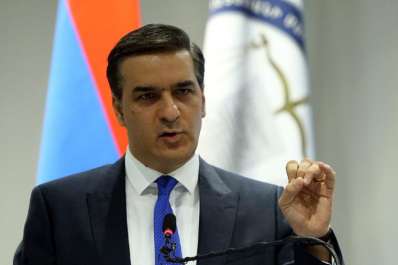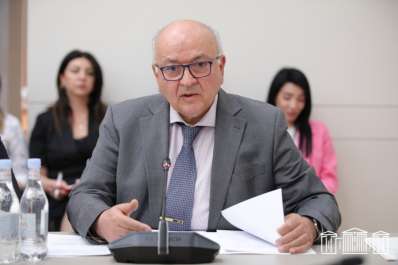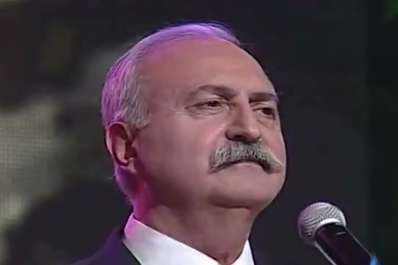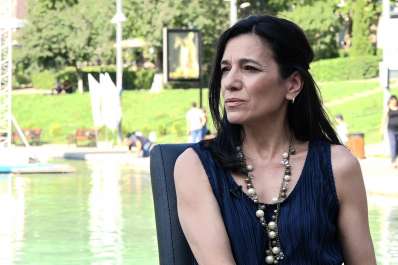
«Կոչ արթնության»․ բողոքի և իրազեկման ակցիա՝ Գյումրիում (լուսանկարներ)
«Կոչ արթնության»․ Գյումրիում Շիրակի Թեմի երիտասարդաց միության նախաձեռնությամբ բողոքի և իրազեկման ակցիա է իրականացվել։ Այս մասին հայտնում է «Տավուշը Հանուն հայրենիքի» ֆեյսբուքյան էջը։

Բերման ենթարկելով իմ տղային՝ փորձում են ինձ լռեցնել, ես հետ չեմ կանգնելու. գնդապետ Մախսուդյան (տեսանյութ)

Հերիք եղա՛վ, մենք ստի մեջ չպիտի ապրենք. Արսեն Գրիգորյանը՝ Ոսկեպարից (տեսանյութ)

Չի կարելի բեկել այս գործընթացը. սա ցանցային պայքար է. Սուրեն Պետրոսյանը Կիրանցում է (տեսանյութ)

ԼՂ թեման փակելու բոլոր փորձերը ձախողելու են․ Հայկ Բաբուխանյան
Բոլոր փորձերը՝ պակելու Արցախի թեման, ձախողելու են, քանի որ հայ ժողովուրդը երբեք չի մոռանա և չի համակերպվի ցեղասպանության հետ, որը տեղի ունեցավ Արցախում։ Այս մասին այսօր «Ընդհանուր հաղթանակ, ընդհանուր ճակատագիր» խորագրով համաժողովին ասաց «Ուժեղ Հայաստան Ռուսաստանի հետ. հանուն նոր միության» շարժման համակարգող, «Սահմանադրական իրավունք» կուսակցության նախագահ Հայկ Բաբուխանյանը։ «Որքան էլ Փաշինյանն ու Ալիևը չցանկանան, այնուամենայնիվ, մեր շարժումը ընդգծում է, որ Արցախը հանդիսանում է մեր երկր...

ՈւՂԻՂ. Հանրահավաք Ազնավուրի հրապարակում Փաշինյանի հեռացման պահանջով





















































































 Ամենադիտված
Ամենադիտված 
 Մայիսի 20-ից Վրաստան ենք գնալու Ադրբեջանի միջով. նոր քարտեզ սահմանազատումից հետո
Մայիսի 20-ից Վրաստան ենք գնալու Ադրբեջանի միջով. նոր քարտեզ սահմանազատումից հետո 
















































































 «Ոտքի՛ քանի չի հանձնել» գրությամբ պաստառներ՝ Հայաստանի մարզերում (լուսանկարներ)
«Ոտքի՛ քանի չի հանձնել» գրությամբ պաստառներ՝ Հայաստանի մարզերում (լուսանկարներ)
 «Կոչ արթնության»․ բողոքի և իրազեկման ակցիա՝ Գյումրիում (լուսանկարներ)
«Կոչ արթնության»․ բողոքի և իրազեկման ակցիա՝ Գյումրիում (լուսանկարներ)
 ԱՄՆ-ում հզոր տորնադո է գրանցվել. կան զոհեր (լուսանկարներ)
ԱՄՆ-ում հզոր տորնադո է գրանցվել. կան զոհեր (լուսանկարներ)
 ԱՄՆ համալսարաններում զանգվածային բողոքի ցույցեր են (լուսանկարներ)
ԱՄՆ համալսարաններում զանգվածային բողոքի ցույցեր են (լուսանկարներ)
 Մոսկվայում ցուցադրել են ռազմավարը՝ Ուկրաինայի և ՆԱՏՕ-ի զինտեխնիկան (լուսանկարներ)
Մոսկվայում ցուցադրել են ռազմավարը՝ Ուկրաինայի և ՆԱՏՕ-ի զինտեխնիկան (լուսանկարներ)
 «Ոտքի՛ քանի չի հանձնել» գրությամբ պաստառներ են հայտնվել Երևանի տարբեր վարչական շրջաններում (լուսանկարներ)
«Ոտքի՛ քանի չի հանձնել» գրությամբ պաստառներ են հայտնվել Երևանի տարբեր վարչական շրջաններում (լուսանկարներ)
 Նիկոլ Փաշինյանը լուսանկար է հրապարակել տիկնոջ հետ
Նիկոլ Փաշինյանը լուսանկար է հրապարակել տիկնոջ հետ
 Ախալքալաքում անցկացվել է պահանջատիրական ջահերով երթ (լուսանկարներ)
Ախալքալաքում անցկացվել է պահանջատիրական ջահերով երթ (լուսանկարներ)
 Հայաստանում Ֆրանսիայի դեսպան Օլիվիե Դըկոտինյին Հայոց ցեղասպանության տարելիցին նվիրված գրառում է արել
Հայաստանում Ֆրանսիայի դեսպան Օլիվիե Դըկոտինյին Հայոց ցեղասպանության տարելիցին նվիրված գրառում է արել
 Երևանում ընթանում է ջահերով երթ՝ նվիրված Հայոց ցեղասպանության զոհերի հիշատակին (տեսանյութ, լուսանկարներ)
Երևանում ընթանում է ջահերով երթ՝ նվիրված Հայոց ցեղասպանության զոհերի հիշատակին (տեսանյութ, լուսանկարներ)
 Nissan Qashqai-ը նոր թարմացված մոդել է ներկայացրել (լուսանկարներ)
Nissan Qashqai-ը նոր թարմացված մոդել է ներկայացրել (լուսանկարներ)
 Ռուսաստանում սպանել են երկու ոստիկանի, հափշտակել նրանց զենքն ու դիմել փախուստի (լուսանկարներ)
Ռուսաստանում սպանել են երկու ոստիկանի, հափշտակել նրանց զենքն ու դիմել փախուստի (լուսանկարներ)